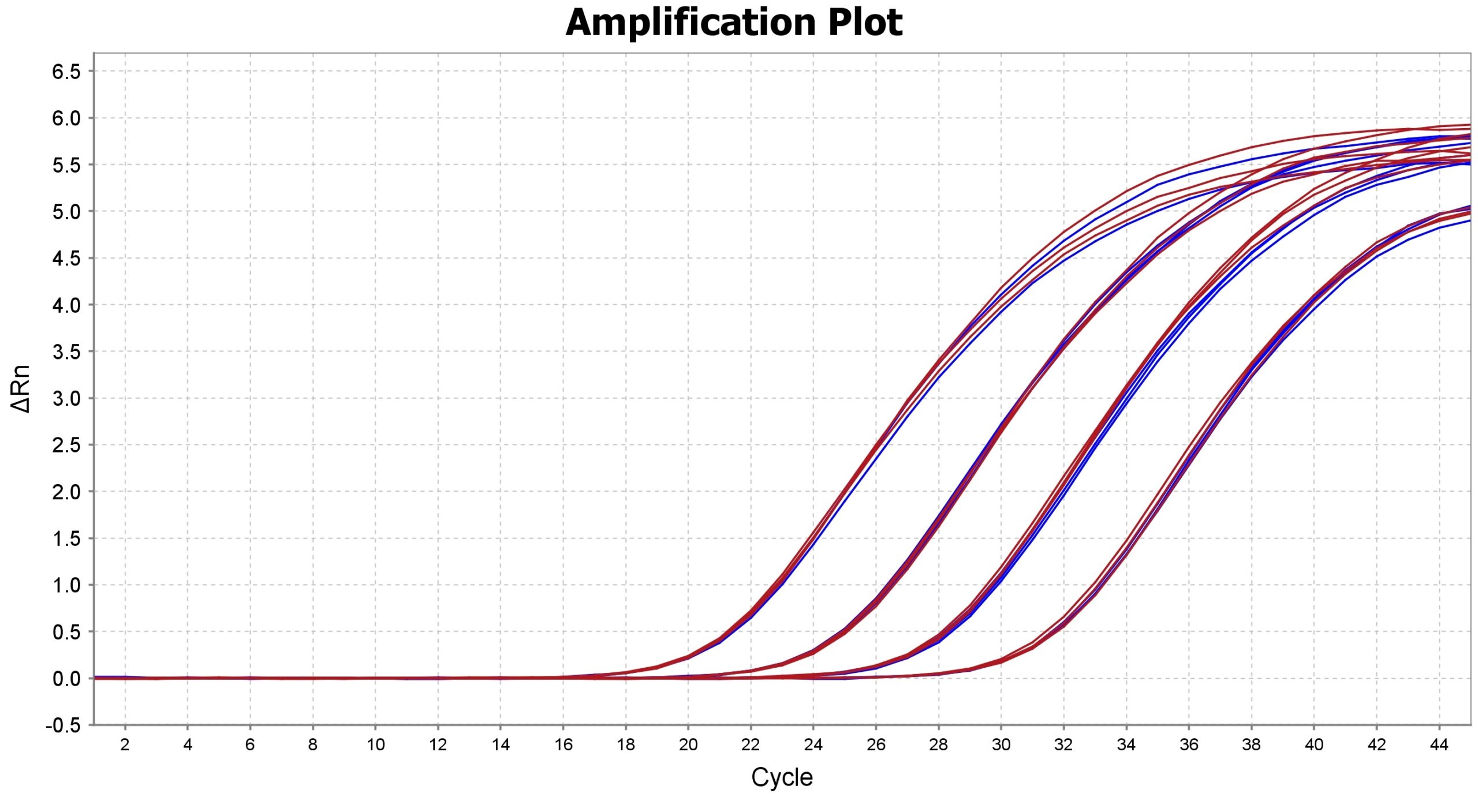Lyo-Ready 1-Step RT-qPCR Buffer
Molecular diagnostic tests are progressively moving towards lyophilization. There are several advantages for this, including room temperature shipping and storage, extended shelf-life and increased flexibility in sample volume. In order to be compatible with drying however, enzyme preparations must be glycerol-free and include specialized excipients that preserve the mixture as it is exposed to freezing, vacuum and dehydration.
Retention of reverse transcriptase activity following lyophilization

Glycerol-Free Taq HS 50 U/µL (MDX011), 100x Lyo-compatible MMLV-RT (MDX042), primers and probes were added to Lyo-Ready 1-Step RT-qPCR Buffer (MDX052), dried down and rehydrated (red) and tested against a freshly prepared wet mix (blue), in a triplex probe RT-qPCR assay on mouse RNA. The results demonstrate the same reverse transcriptase and polymerase enzyme activity before and following lyophilization.
Lyo-Ready 1-Step RT-qPCR Buffer, MDX052
不含甘油的 RT-qPCR 反应缓冲液含有溶菌酶,设计用于在快速热循环条件下提供高重现性、准确的 RT-qPCR 检测结果。
文档与资源
Description
Lyo-Ready 1-Step RT-qPCR Buffer is a glycerol-free qPCR mix containing RNase Inhibitor, reaction buffer, dNTP, MgCl2 and lyo-excipients. In order to produce room temperature lyophilized RT-qPCR reagents, Reverse Transcriptase, Taq polymerase, assay specific primers and probes are added to Lyo-Ready 1-Step RT-qPCR Buffer for subsequent lyophilization.
Specifications
| Description | A glycerol-free RT-qPCR reaction buffer containing lyo-excipients. In order to produce room temperature lyophilized qPCR reagents, a lyo-compatible Taq DNA polymerase, assay specific primers and probes are added for subsequent lyophilization. |
| Concentration | 2x |
| Appearance | Clear, colorless solution |
| Application | RT-qPCR |
| Sample type | RNA, cDNA, DNA |
| Presentation | 1 vial |
| Storage | -20 °C |
| Mix stability | See outer label |
| Consistency | ± 0.5 Ct variance between test and reference sample |
| DNA Contamination | None detected in PCR amplification with traces overlay with the negative control on E. coli and mouse genomic DNA specific targets. |
| DNase Contamination | No detectable degradation |
| RNase Contamination | No detectable degradation |
产品资料
分子诊断的原料试剂解决方案分子诊断的原料试剂解决方案
开发常温稳定检测的分子试剂开发常温稳定检测的分子试剂
FAQs: Lyo-Ready 1-Step RT-qPCR Buffer
Slope of standard 10-fold dilution curve indicates qPCR efficiency. The efficiency of the qPCR should be between 90–110% (−3.58 ≥ slope ≥ −3.1). If the efficiency is greater than 100%, this indicated inaccurate sample and reagent pipetting, if it is less than 100%, this indicates your samples may contain PCR inhibitors or your qPCR primer and/or probe design may not be optimal.
Yes, reaction conditions are the same and they will produce the same Ct values, even with multiplex RT-qPCR assays. This means that the liquid mixes can be used to create SOPs if you do not want to lyophilize and then later if lyophilization is required (for example to increase sensitivity), the SOP can be updated for lyophilization, it does not require completely new SOPs to be written.
Many fluorescent RT-qPCR primer- and probe-based chemistries have been devised and are available from different commercial vendors for molecular diagnostic tests, the two most used are:
– Hydrolysis (TaqMan) probes. The main advantages of using hydrolysis probes are high specificity, a high signal-to-noise ratio, and the ability to perform multiplex qPCR reactions. The disadvantages are that the initial cost of the probe.
– Molecular beacons. Molecular beacons are highly specific, can be used for multiplexing, and if the target sequence does not match the beacon sequence exactly, hybridization and fluorescence will not occur. Unlike hydrolysis probes, molecular beacons are displaced but not destroyed during amplification and can be used for melt curve analysis if necessary. The main disadvantage is that they are difficult to design, requiring a stable hairpin stem that is strong enough that the molecule will not spontaneously fold into non-hairpin conformations but not be too strong, or it may not properly hybridize to the target.
The Lyo-Ready 1-Step RT-qPCR Buffer has some inhibitor tolerance, but for amplification from crude lysates or inhibitor-rich samples we recommend using are optimized Lyo-Ready Specimen-specific™ (blood, saliva, urine, stool, and plant) RT-qPCR and RT-LAMP mixes.
Following lyophilization in the presence or absence of primers and probes, the Lyo-Ready RT-qPCR Mix is stable for a minimum of 24 months at ambient temperature (17 – 23 °C). Following rehydration, the assay reproducibility, sensitivity, and robustness will be the same as for a freshly made liquid mix, making the mixes ideal for point-of-care molecular diagnostic tests and microfluidic qPCR devices.
No, our lyo-excipients are proprietary.
与我们的专业团队联系
想了解更多迈迪安免疫和分子产品信息?欢迎与我们联系